House of Stuart
The House of Stuart, originally spelled Stewart, was a royal house of Scotland, England, Ireland and later Great Britain. The family name comes from the office of High Steward of Scotland, which had been held by the family progenitor Walter fitz Alan (c. 1150). The name Stewart and variations had become established as a family name by the time of his grandson Walter Stewart. The first monarch of the Stewart line was Robert II, whose male-line descendants were kings and queens in Scotland from 1371, and of England, Ireland and Great Britain from 1603, until 1714. Mary, Queen of Scots (r.1542-1567), was brought up in France where she adopted the French spelling of the name Stuart.
| Stuart Stewart | |
|---|---|
| Royal house | |
.svg.png.webp) Coat of arms of James VI and I, 1603–1649 | |
| Parent family | Clan Stewart |
| Country | Scotland, England, Ireland, Great Britain |
| Founded | c. 1371 (652 years ago) |
| Founder | Robert II of Scotland (1371–1390) |
| Final ruler | Anne, Queen of Great Britain (1702–1714) |
| Titles | |
| Dissolution | 1807 |
| Cadet branches | List
|
In 1503, James IV married Margaret Tudor, thus linking the reigning royal houses of Scotland and England. Margaret's niece, Elizabeth I of England died without issue in 1603, and James IV's and Margaret's great-grandson James VI of Scotland succeeded to the thrones of England and Ireland as James I in the Union of the Crowns. The Stuarts were monarchs of Britain and Ireland and its growing empire until the death of Queen Anne in 1714, except for the period of the Commonwealth between 1649 and 1660.[note 3]
In total, nine Stewart/Stuart monarchs ruled Scotland alone from 1371 until 1603, the last of whom was James VI, before his accession in England. Two Stuart queens ruled the isles following the Glorious Revolution in 1688: Mary II and Anne. Both were the Protestant daughters of James VII and II by his first wife Anne Hyde and the great-grandchildren of James VI and I. Their father had converted to Catholicism and his new wife gave birth to a son in 1688, who was to be brought up as a Roman Catholic; so James was deposed by Parliament in 1689, in favour of his daughters. However, neither daughter had any children who survived to adulthood, so the crown passed to the House of Hanover on the death of Queen Anne in 1714 under the terms of the Act of Settlement 1701 and the Act of Security 1704. The House of Hanover had become linked to the House of Stuart through the line of Elizabeth Stuart, Queen of Bohemia.
After the loss of the throne, the descendants of James VII and II continued for several generations to attempt to reclaim the Scottish and English (and later British) throne as the rightful heirs, their supporters being known as Jacobites. Since the early 19th century, when the James II direct line failed, there have been no active claimants from the Stuart family. The current Jacobite heir to the claims of the historical Stuart monarchs is a distant cousin Franz, Duke of Bavaria, of the House of Wittelsbach. The senior living member of the royal Stewart family, descended in a legitimate male line from Robert II of Scotland, is Arthur Stuart, 8th Earl Castle Stewart.
Background
The ancestral origins of the Stuart family are obscure—their probable ancestry is traced back to Alan FitzFlaad, a Breton who went to England not long after the Norman conquest.[1] Alan had been the hereditary steward of the Bishop of Dol in the Duchy of Brittany;[2] Alan had a good relationship with Henry I of England who awarded him with lands in Shropshire.[2] The FitzAlan family quickly established themselves as a prominent Anglo-Norman noble house, with some of its members serving as High Sheriff of Shropshire.[2][3] It was the son of Alan named Walter FitzAlan who became the first hereditary High Steward of Scotland, while his brother William's family went on to become Earls of Arundel.
When the civil war in the Kingdom of England, known as The Anarchy, broke out between the legitimist claimant Matilda, Lady of the English, and her cousin who had usurped her, King Stephen, Walter had sided with Matilda.[4] Another supporter of Matilda was her uncle David I of Scotland from the House of Dunkeld.[4] After Matilda was pushed out of England into the County of Anjou, essentially failing in her legitimist attempt for the throne, many of her supporters in England fled also. It was then that Walter followed David up to the Kingdom of Scotland, where he was granted lands in Renfrewshire and the title for life of Lord High Steward.[4] The next monarch of Scotland, Malcolm IV, made the High Steward title a hereditary arrangement. While High Stewards, the family were based at Dundonald, South Ayrshire, between the 12th and 13th centuries.
History
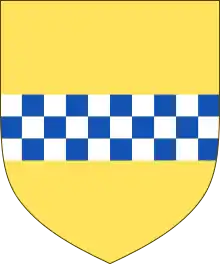 undiffered arms of stewart |
.svg.png.webp) Arms of Stewart of Albany |
|
|---|---|---|
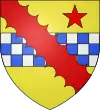 Arms of Stewart of Barclye |
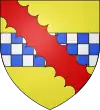 Arms of Stewart of Garlies |
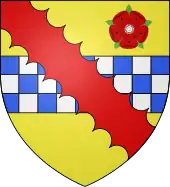 Arms of Stewart of Minto |
.svg.png.webp) Arms of Stewart of Atholl |
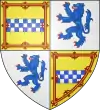 Arms of Stewart of Bute |
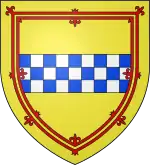 Arms of Stuart of Bute |
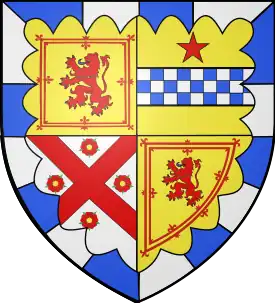 Arms of Stewart of Ardvorlich |
.svg.png.webp) Arms of Stewart of Physgill |
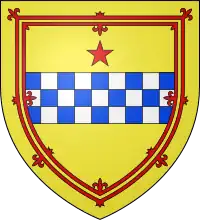 Arms of Stewart of Rothesay |
The sixth High Steward of Scotland, Walter Stewart (1293–1326), married Marjorie, daughter of Robert the Bruce, and also played an important part in the Battle of Bannockburn gaining further favour. Their son Robert was heir to the House of Bruce, the Lordship of Cunningham and the Bruce lands of Bourtreehill; he eventually inherited the Scottish throne when his uncle David II died childless in 1371.
In 1503, James IV attempted to secure peace with England by marrying King Henry VII's daughter, Margaret Tudor. The birth of their son, later James V, brought the House of Stewart into the line of descent of the House of Tudor, and the English throne. Margaret Tudor later married Archibald Douglas, 6th Earl of Angus, and their daughter, Margaret Douglas, was the mother of Henry Stuart, Lord Darnley. In 1565, Darnley married his half-cousin Mary, Queen of Scots, the daughter of James V. Darnley's father was Matthew Stewart, 4th Earl of Lennox, a member of the Stewart of Darnley branch of the House. Lennox was a descendant of Alexander Stewart, 4th High Steward of Scotland, also descended from James II, being Mary's heir presumptive. Thus Darnley was also related to Mary on his father's side and because of this connection, Mary's heirs remained part of the House of Stuart. Following John Stewart of Darnley's ennoblement for his part at the Battle of Baugé in 1421 and the grant of lands to him at Aubigny and Concressault, the Darnley Stewarts' surname was gallicised to Stuart.
Both Mary, Queen of Scots, and Lord Darnley had strong claims on the English throne through their mutual grandmother Margaret Tudor. This eventually led to the accession of the couple's only child James as King of Scotland, England, and Ireland in 1603. However, this was a personal union, as the three Kingdoms shared a monarch, but had separate governments, churches, and institutions. Indeed, the personal union did not prevent an armed conflict, known as the Bishops' Wars, breaking out between England and Scotland in 1639. This was to become part of the cycle of political and military conflict that marked the reign of Charles I of England, Scotland and Ireland, culminating in a series of conflicts known as the War of the Three Kingdoms. The trial and execution of Charles I by the English Parliament in 1649 began 11 years of republican government known as the English Interregnum. Scotland initially recognised the late King's son, also called Charles, as their monarch, before being subjugated and forced to enter Cromwell's Commonwealth by General Monck's occupying army. During this period, the principal members of the House of Stuart lived in exile in mainland Europe. The younger Charles returned to Britain to assume his three thrones in 1660 as "Charles II of England, Scotland and Ireland" - with the support of General Monck - but dated his reign from his father's death eleven years before.
In feudal and dynastic terms, the Scottish reliance on French support was revived during the reign of Charles II, whose own mother was French. His sister Henrietta married into the French royal family. Charles II left no legitimate children, but his numerous illegitimate descendants included the Dukes of Buccleuch, the Dukes of Grafton, the Dukes of Saint Albans and the Dukes of Richmond.
.JPG.webp)
These French and Roman Catholic connections proved unpopular and resulted in the downfall of the Stuarts, whose mutual enemies identified with Protestantism and because James VII and II offended the Anglican establishment by proposing tolerance not only for Catholics but for Protestant Dissenters. The Glorious Revolution caused the overthrow of King James in favour of his son-in-law and his daughter, William and Mary. James continued to claim the thrones of England and Scotland to which he had been crowned, and encouraged revolts in his name, and his grandson Charles (also known as Bonnie Prince Charlie) led an ultimately unsuccessful rising in 1745, ironically becoming symbols of conservative rebellion and Romanticism. Some blame the identification of the Roman Catholic Church with the Stuarts for the extremely lengthy delay in the passage of Catholic emancipation until Jacobitism (as represented by direct Stuart heirs) was extinguished; however it was as likely to be caused by entrenched anti-Catholic prejudice among the Anglican establishment of England. Despite the Whig intentions of tolerance to be extended to Irish subjects, this was not the preference of Georgian Tories and their failure at compromise played a subsequent role in the present division of Ireland.
Present-day
The Royal House of Stuart became extinct with the death of Cardinal Henry Benedict Stuart, brother of Charles Edward Stuart, in 1807. Duke Francis of Bavaria is the current senior heir.[5] However, Charles II had a number of illegitimate sons whose surviving descendants in the male line include Charles Gordon-Lennox, 11th Duke of Richmond; Henry FitzRoy, 12th Duke of Grafton; Murray Beauclerk, 14th Duke of St Albans; and Richard Scott, 10th Duke of Buccleuch. In addition, James II's illegitimate son, James FitzJames, 1st Duke of Berwick, founded the House of FitzJames comprising two branches, one in France and one in Spain. The last of the French branch died in 1967; the senior heir of James II's male-line descendants is Jacobo Hernando Fitz-James Stuart, 20th Duke of Peñaranda de Duero.
List of monarchs
Monarchs of Scotland
| Portrait | Name | From | Until | Relationship with predecessor |
|---|---|---|---|---|
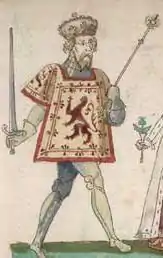 | Robert II | 22 February 1371 | 19 April 1390 | Nephew[6] of David II who died without issue. Robert's mother Marjorie Bruce was daughter of Robert I. |
 | Robert III | 19 April 1390 | 4 April 1406 | Son of Robert II. |
 | James I | 4 April 1406 | 21 February 1437 | Son of Robert III. |
 | James II | 21 February 1437 | 3 August 1460 | Son of James I. |
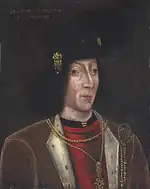 | James III | 3 August 1460 | 11 June 1488 | Son of James II. |
 | James IV | 11 June 1488 | 9 September 1513 | Son of James III. |
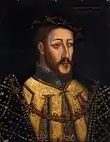 | James V | 9 September 1513 | 14 December 1542 | Son of James IV. |
 | Mary | 14 December 1542 | 24 July 1567 | Daughter of James V. |
 | James VI | 24 July 1567 | 27 March 1625 | Son of Mary, Queen of Scots. |
Monarchs of England, Scotland and Ireland
From the Acts of Union 1707, which came into effect on 1 May 1707, the last Stuart monarch, Anne, became Queen of Great Britain and Ireland.
| Portrait | Name | From | Until | Relationship with predecessor |
|---|---|---|---|---|
 | James VI and I | 24 March 1603 | 27 March 1625 | Great-Great grandson of Henry VII of England. King of Scotland alone until inheriting the titles King of England and Ireland, including claim to France from the extinct Tudors. |
 | Charles I | 27 March 1625 | 30 January 1649 (executed) | Son of James VI and I |
 | Charles II | 30 January 1649 (de jure); 2 May 1660 (de facto) | 6 February 1685 | Son of Charles I. Prohibited by Parliament from assuming the throne during a republican period of government known as the Commonwealth of England, but then accepted as king in 1661. |
 | James VII and II | 6 February 1685 | 11 December 1688 | Brother of Charles II, who died without legitimate issue. Son of Charles I. Overthrown at the Revolution of 1688. Died in 1701. |
 | Mary II | 13 February 1689 | 28 December 1694 | Daughter of James II & VII, who was still alive and pretending to the throne. Co-monarch was William III & II who outlived his wife. |
 | Anne | 8 March 1702 | 1 August 1714 | Sister of Mary II. daughter of James II & VII. Name of state changed to Great Britain with the political Acts of Union 1707, though family has used title since James I & VI. Died childless, rights pass to House of Hanover. |
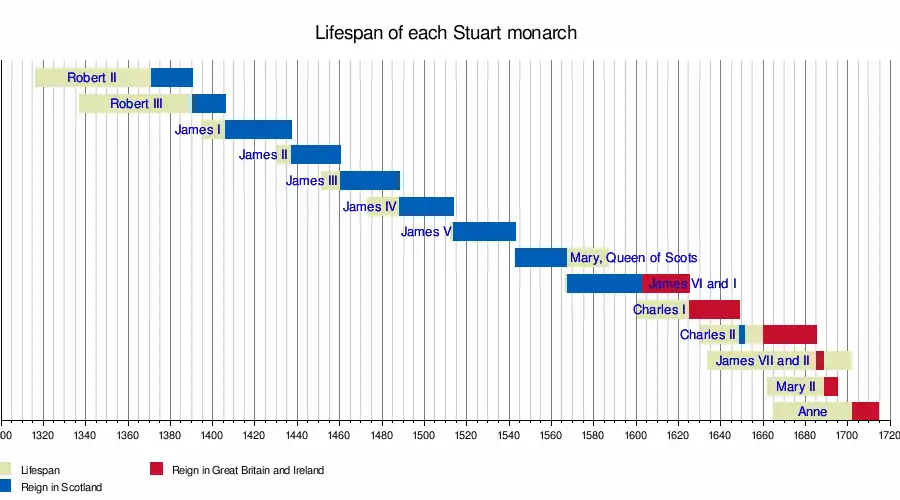
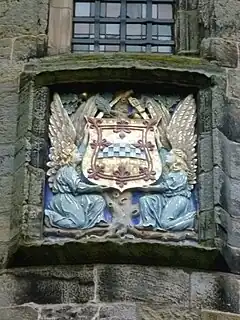
Family tree
Round provided a family tree[7] to embody his essential findings, which is adapted below.
| Alan, Dapifer Dolensis (Seneschal or Steward of Dol) | |||||||||||||||||||||||
| Alan, Dapifer Dolensis, Took part in First Crusade, 1097. | Flaald Occurs at Monmouth, 1101/2 | Rhiwallon Monk of St Florent. | |||||||||||||||||||||
| Alan Fitz Flaad, Founder of Sporle Priory | |||||||||||||||||||||||
| Jordan Fitz Alan, Dapifer in Brittany, Benefactor of Sele Priory. | William Fitz Alan, Lord of Oswestry Founder/benefactor of Haughmond Abbey, Died 1160 | Walter fitz Alan Dapifer Regis Scotiae, Founder of Paisley Abbey, Died 1177 | |||||||||||||||||||||
| Alan Fitz Jordan, Dapifer Dolensis. | William Fitz Alan II, Lord of Oswestry and Clun | Alan the Steward Senescallus Regis Scotiae | |||||||||||||||||||||
Origin
- Alan fitz Flaad
- William FitzAlan, Lord of Oswestry
- Jordan fitz Alan, Seneschal of Dol
- Walter fitz Alan, 1st High Steward of Scotland
- Alan fitz Walter, 2nd High Steward of Scotland
- Walter Stewart, 3rd High Steward of Scotland
- Alexander Stewart, 4th High Steward of Scotland
- James Stewart, 5th High Steward of Scotland
- Walter Stewart, 6th High Steward of Scotland
- Robert II of Scotland
- John Stewart of Ralston
- Walter Stewart, 6th High Steward of Scotland
- John Stewart of Bonkyll
- Alexander Stewart of Bonkyll
- Earls of Angus (extinct 1361)
- Alan Stewart of Dreghorn
- Stewart of Darnley
- Earls of Lennox
- Stewart of Garlies
- Earls of Galloway
- Stewart of Burray
- Stewart of Physgill (Phisgal)
- Stewart of Minto
- Stewart of Tongrie
- Stewart of Barclye
- Stewart of Darnley
- Walter Stewart of Garlies and Dalswinton
- John Stewart of Dalswinton
- Walter Stewart of Garlies and Dalswinton
- John Stewart of Dalswinton
- James Stewart of Pearston
- Stewart of Pearston
- Stewart of Lorn
- Earls of Atholl
- Earls of Buchan
- Earls of Traquair (illegitimate)
- Stewart of Pearston
- John Stewart of Daldon
- Robert Stewart of Daldowie
- Alexander Stewart of Bonkyll
- James Stewart, 5th High Steward of Scotland
- Walter Bailloch
- Robert Stewart, Lord of Darnley
- Alexander Stewart, 4th High Steward of Scotland
- Walter Stewart, 3rd High Steward of Scotland
- Alan fitz Walter, 2nd High Steward of Scotland
- Simon fitz Alan
House of Stewart
- Robert II of Scotland
- Robert III of Scotland
- David Stewart, Duke of Rothesay
- James I of Scotland
- Alexander Stewart, Duke of Rothesay
- James II of Scotland
- Sir John Stewart (illegitimate)
- Stewart of Ballechin
- Walter, Lord of Fife
- Robert Stewart, Duke of Albany
- Murdoch Stewart, Duke of Albany
- Robert Stewart
- Walter Stewart
- Lords Avandale
- Lords Stuart of Ochiltree
- Barons Castle Stewart
- Lords Stuart of Ochiltree
- Lords Avandale
- Alasdair Stewart
- James Mor Stewart
- James "Beag" Stewart (illegitimate)
- Stewart of Balquhidder
- Stewart of Ardvorlich
- Stewart of Glen Buckie
- Stewart of Gartnafuaran
- Stewart of Annat
- Stewart of Balquhidder
- James "Beag" Stewart (illegitimate)
- John Stewart, Earl of Buchan
- Robert Stewart, Earl of Ross
- Murdoch Stewart, Duke of Albany
- Alexander Stewart, Earl of Buchan, the Wolf of Badenoch
- Illegitimate sons
- Stewart of Atholl
- Illegitimate sons
- David Stewart, Earl of Strathearn
- Walter Stewart, Earl of Atholl
- Alan Stewart, 4th Earl of Caithness
- David Stewart, Master of Atholl
- John Stewart, Sheriff of Bute (illegitimate)
- Robert III of Scotland
House of Stuart
Descended from the Stewarts of Darnley (Stewarts of Lennox)
- Henry Stuart, Lord Darnley, husband of Mary, Queen of Scots
- James VI and I
- Henry Frederick, Prince of Wales
- Charles I of England
- Charles II of England
- James Scott, 1st Duke of Monmouth (illegitimate)
- Charles FitzCharles, 1st Earl of Plymouth (illegitimate)
- Charles FitzRoy, 2nd Duke of Cleveland (illegitimate)
- Dukes of Cleveland (extinct 1774)
- Henry FitzRoy, 1st Duke of Grafton (illegitimate)
- George FitzRoy, 1st Duke of Northumberland (illegitimate)
- Charles Beauclerk, 1st Duke of St Albans (illegitimate)
- Charles Lennox, 1st Duke of Richmond (illegitimate)
- James II of England
- Charles Stuart, Duke of Cambridge
- James Stuart, Duke of Cambridge
- Charles Stuart, Duke of Kendal
- Edgar, Duke of Cambridge
- Charles Stuart, Duke of Cambridge
- James Francis Edward Stuart
- James FitzJames, 1st Duke of Berwick (illegitimate)
- House of FitzJames
- Dukes of Berwick
- Dukes of Fitz-James (extinct 1967)
- House of FitzJames
- Henry FitzJames (illegitimate)
- Henry Stuart, Duke of Gloucester
- Charles II of England
- Robert Stuart, Duke of Kintyre and Lorne
- James VI and I
See also
- Jacobitism, for more on the legitimist House of Stuart, following the Glorious Revolution
- John Barbour, the first Stewart court poet and genealogist
- List of Scottish monarchs
- List of British monarchs
- Clan Stewart
- Barony and Castle of Corsehill Stewarton in Ayrshire and the Stuart connection
- Armorial of the House of Stuart
Notes
- titular claim rather than de facto
- Title assumed by James V of Scotland, in correspondence with Irish chieftains, as a challenge to Henry VIII, who had recently been declared 'King of Ireland.'
- The Earls of Galloway are the senior surviving line of the Stuarts. They are descended from a line which originated from the second son of Alexander Stewart, 4th High Steward of Scotland, and are not members of the Stewart/Stuart royal line; however, they are part of the peerage.
References
- "J.H. Round: The Origin of the Stewarts: Part 1". MedievalGenealogy.org.uk. Retrieved on 13 November 2008.
- Bartlett, England Under the Norman and Angevin Kings, 1075–1225, 544.
- Lieber, Encyclopædia Americana, 30.
- King, The Anarchy of King Stephen's Reign, 249.
- Alleyne, Richard; de Quetteville, Harry (7 April 2008). "Act repeal could make Franz Herzog von Bayern new King of England and Scotland". Daily Telegraph. Archived from the original on 8 April 2008. Retrieved 22 June 2008.
- The Oxford Dictionary of National Biography
- "Studies in peerage and family history". New York Longmans, Green. 1901.
Sources
- King, Edmund (1994). The Anarchy of King Stephen's Reign. Oxford University Press. ISBN 0-19-820364-0.
- Barrow, G. W. S. (2003). The Kingdom of the Scots. Edinburgh: Edinburgh University Press. ISBN 0-7486-1802-3.
- Barrow, G. W. S. (2004). "Stewart family (per. c.1110–c.1350)". Oxford Dictionary of National Biography. Oxford Dictionary of National Biography (online ed.). Oxford University Press. doi:10.1093/ref:odnb/49411. Retrieved 11 October 2010. (Subscription or UK public library membership required.)
- Round, J. Horace (1901). Studies in Peerage and Family History. Westminster, London: Archibald Constable & Co Ltd.
Further reading
- Addington, Arthur C. The Royal House of Stuart: The Descendants of King James VI of Scotland (James I of England). 3v. Charles Skilton, 1969–76.
- Cassavetti, Eileen. The Lion & the Lilies: The Stuarts and France. Macdonald & Jane's, 1977.
.svg.png.webp)